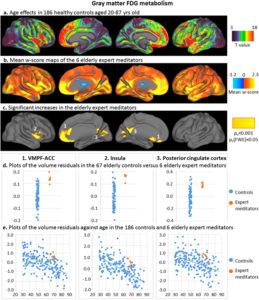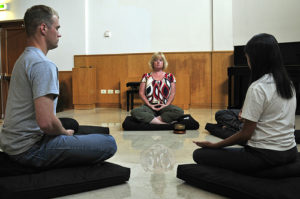Meditation Can Reduce the Age-Associated Degeneration of the Brain
By John M. de Castro, Ph.D.
“The brain begins to decline in the 20s, and continues to decrease in volume and weight through old age. Meditation, in addition to boosting emotional and physical well-being at any time in life, may be an effective way to prevent neurodegenerative diseases like dementia, Alzheimer’s and Parkinson’s, as well as help stave off some of the normal cognitive decline that comes with aging. The strategy is free, and it comes with no side effects.” – Carolyn Gregoire
Human life is one of constant change. We revel in our increases in physical and mental capacities during development, but regret their decreases during aging. The aging process involves a systematic progressive decline in every system in the body, the brain included. Starting in the 20s there is a progressive decrease in the volume and activity of the brain as the years go by.
The nervous system is a dynamic entity, constantly changing and adapting to the environment. It will change size, activity, and connectivity in response to experience. These changes in the brain are called neuroplasticity. Over the last decade neuroscience has been studying the effects of contemplative practices on the brain and has identified neuroplastic changes in widespread area. and have found that meditation practice appears to mold and change the brain, producing psychological, physical, and spiritual benefits. In addition, they have been able to investigate various techniques that might slow the process of neurodegeneration that accompanies normal aging. They’ve found that mindfulness practices reduce the deterioration of the brain that occurs with aging restraining the loss of neural tissue. Indeed, the brains of practitioners of meditation and yoga have been found to degenerate less with aging than non-practitioners.
In today’s Research News article “Reduced age-associated brain changes in expert meditators: a multimodal neuroimaging pilot study.” See summary below or view the full text of the study at: https://www.ncbi.nlm.nih.gov/pmc/articles/PMC5578985/, Chételat and colleagues recruited expert meditators with at least 10 years of experience and a total of at least 15,000 hours of meditation practice and age matched meditation naïve controls. They also included non-meditators at a wide range of ages, 20-87 years. They all underwent scanning of the brain with either Positron Emission Tomography (PET) or Magnetic Resonance Imaging (MRI). They were measured for verbal fluency, episodic memory, short-term memory, and working memory, processing speed and executive functions, frequency of participation in leisure activities before 30 and from 30 to 65 years, and the highest level of occupation reached, adherence to Mediterranean diet, sleep quality and sleep disturbance.
They found that the older the meditation naïve participants the lower the volume of the brain gray matter and the lower the brain metabolism. Hence, they demonstrated, as have many others, age related degeneration of the brain. On the other hand, the expert meditators had significantly greater brain gray matter volume and metabolic activity than the age matched controls in the bilateral ventromedial prefrontal and anterior cingulate cortex, insula, temporo-parietal junction, and posterior cingulate cortex /precuneus. All of the expert meditators were over 60 yet their brain volumes were in the range of meditation naïve controls in their 30s and 40s.
These are remarkable results that suggest that large amounts of meditation practice can help to preserve the brain countering age related decline. The amount of meditation performed by these expert meditators is so high as to be unrealistic for use with the general population. Fortunately, other research suggests that the elderly brain changes positively in response to much lower amounts of mindfulness practice. So, mindfulness training may well be a feasible practice to protect the brains of seniors from further deterioration.
So, use meditation to reduce the age-associated degeneration of the brain
“A growing body of research supports the immediate benefits of meditation, such as reduced stress and anxiety levels, lower blood pressure, and enhanced happiness. Studies on mindfulness interventions show these effects are common in as few as eight weeks. While these initial perks may be reason enough for us to practice, meditation’s positive impact appears to be even more far-reaching, potentially adding years to our lives and improving cognitive function well into old age.” – Rina Deshpande
CMCS – Center for Mindfulness and Contemplative Studies
This and other Contemplative Studies posts are also available on Google+ https://plus.google.com/106784388191201299496/posts and on Twitter @MindfulResearch
Study Summary
Chételat, G., Mézenge, F., Tomadesso, C., Landeau, B., Arenaza-Urquijo, E., Rauchs, G., … Lutz, A. (2017). Reduced age-associated brain changes in expert meditators: a multimodal neuroimaging pilot study. Scientific Reports, 7, 10160. http://doi.org/10.1038/s41598-017-07764-x
Abstract
Aging is associated with progressive cerebral volume and glucose metabolism decreases. Conditions such as stress and sleep difficulties exacerbate these changes and are risk factors for Alzheimer’s disease. Meditation practice, aiming towards stress reduction and emotion regulation, can downregulate these adverse factors. In this pilot study, we explored the possibility that lifelong meditation practice might reduce age-related brain changes by comparing structural MRI and FDG-PET data in 6 elderly expert meditators versus 67 elderly controls. We found increased gray matter volume and/or FDG metabolism in elderly expert meditators compared to controls in the bilateral ventromedial prefrontal and anterior cingulate cortex, insula, temporo-parietal junction, and posterior cingulate cortex /precuneus. Most of these regions were also those exhibiting the strongest effects of age when assessed in a cohort of 186 controls aged 20 to 87 years. Moreover, complementary analyses showed that these changes were still observed when adjusting for lifestyle factors or using a smaller group of controls matched for education. Pending replication in a larger cohort of elderly expert meditators and longitudinal studies, these findings suggest that meditation practice could reduce age-associated structural and functional brain changes.









